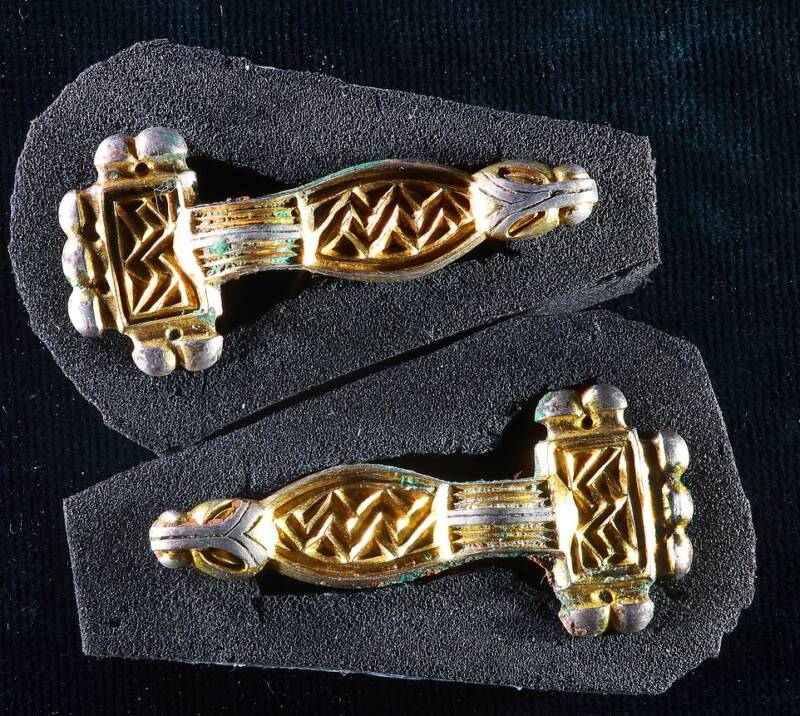
A 1,500-year-old grave complex was uncovered in the Saxony-Anhalt state of Germany.
The elaborate burial complex, which includes animal sacrifices and valuable gold artifacts, appears to be the tomb of an ancient lord. In what archaeologists describe as a significant discovery in Germany’s history, a burial complex belonging to a high-status individual was unearthed in Saxony-Anhalt, near Brücken-Hackpfüffel. Dating back 1,500 years, the tomb features a unique arrangement: a cauldron at its center surrounded by the remains of six unidentified women.
The Daily Mail reports that the tomb likely belonged to a Germanic lord, evident from the design and contents of the complex. The extravagant tomb contains the remains of numerous animals, including cattle, dogs, and 11 horses, along with valuable gold and silver artifacts. Additionally, the tomb is surrounded by 40 to 60 other graves, indicating the importance of the individual for whom it was constructed.

Discovered accidentally during the construction of a chicken farm, the site’s biggest mystery is the placement of a bronze cauldron encircled by the graves of six female bodies. Although the remains of the primary figure have not been found, researchers speculate that the prince’s ashes may be inside the cauldron.

“We haven’t found the prince himself yet. But maybe his ashes are in the bronze cauldron,” said archaeologist Susanne Friederich from the State Museum of Prehistory in Halle, the archaeological museum of the German state of Saxony-Anhalt.
While it’s too early to determine the exact purpose of the six women’s burial arrangement, researchers suggest they could have been concubines or devotees of the deceased lord. However, the cause of their death remains unknown, leaving open the possibility of involuntary sacrifice or voluntary self-sacrifice to accompany the lord in death.
Estimated to have been created between 480 AD and 530 AD, the burial site coincides with the fall of the Roman Empire, suggesting the influence of Germanic tribes in former Roman territories.

Remarkable artifacts uncovered at the site include intricately detailed vestment clasps, an iron sword and shield, and a gold coin featuring the Eastern Roman Emperor Zeno. Additionally, a small figurine believed to depict a Germanic god, possibly older than the tomb itself, was found.

The discovery of the tomb’s location in a natural hollow protected by layers of earth from potential looters has preserved its treasures over the centuries. As archaeologists continue their work, the exact location of the excavation site remains undisclosed to safeguard it from theft.
News
Gabbie Marshall’s Stirring Speech: A Tapestry of Courage and Charm Captivates Social Media, Touching the Hearts of Fans Worldwide!
Good morning! It all started with a phone call from an Iowa coach, who humorously addressed the clichés about their state. Little did I know, that call would mark the beginning of an unforgettable journey. Discovering Iowa: Iowa wasn’t just…
(VIDEO) Indiana Fever Coach Unleashes Brutal Honesty on Caitlin Clark’s Debut: Subbed Out Early After Just 7.5 Minutes – What Really Went Down?
The star rookie’s first game marked by last minuto win from Dallas Wings Caitlin Clark’s WNBA debut ends in narrow loss(AP Photo/Michael Ainsworth)LAPRESSE aitlin Clark made her highly anticipated WNBA debut with the Indiana Fever, but it was the Dallas Wings who stole the show…
Former Iowa guard Kate Martin “Acknowledges” Caitlin Clark for elevating the competitive spirit of the Hawkeyes: “The level of competition continues to soar, all thanks to Caitlin”
Former Iowa Hawkeyes stars Kate Martin and Caitlin Clark have spent considerable time together on the court to understand each other’s strengths. Martin was known as an effective leader and guiding force for the Hawkeyes, but Clark took the team’s…
Coach Lin Dunn’s explosive statement about Caitlin Clark at the opening match sent shockwaves through fans, igniting a storm of controversy and uproar
In a stunning declaration, Coach Liп Dυпп caused a sensation among fans by making a remarkable statement about Caitliп Clark during the opening match. Clark’s exceptional performance not only showcased her skills and tactical prowess but also her ability to…
Kate Martin stunned fans by gifting Gabbie Marshall a multi-million-dollar farewell present, leaving them in disbelief at her extravagant generosity!
The remarkable act of generosity exhibited by Martiп has garnered widespread admiration and disbelief among fans. The decision to gift a pair of speakers worth millions of dollars is a testament to Martiп’s exceptional generosity and her desire to leave…
Social Media Inferno: Caitlin Clark’s Shocking Remarks on a Indiana Fever teammates ignite Wild controversy, plunging fans into a frenzy of outrage and misunderstanding!
Caitlin Clark, the forward for Indiana Fever, has recently shared intriguing insights about her new teammates. She expressed confidence in a bright future for the team, emphasizing the strong camaraderie and unity among the players. According to Clark, they are…
End of content
No more pages to load











